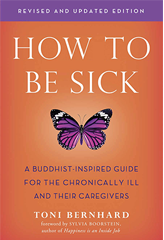Health
Tips for Managing Chronic Illness — Including Mental Health
How to cope with chronic or recurring health conditions.
Posted October 26, 2018 Reviewed by Abigail Fagan

Back in 2015, I developed an intense pain condition and one of my go-to people for support during that time was my fellow PT blogger colleague, Toni Bernhard. Toni writes about how to live well when you're managing chronic pain and illness. Her work helped me stay calm and cope with the uncertainty of having a problem of unknown cause/duration, and felt very de-stigmatizing.
Luckily, my problem has gotten a lot better, and now it only flares up intermittently at a much milder intensity than it originally did. However, every time it recurs, I'm somewhat fearful it's going to get worse, and I have to manage that anxiety. When it recurs, it's a sign I need to take it easier, and use strategies to de-stress and help prevent the pain pathways from strengthening. Some of the strategies I use, I learned from Toni.

Toni has written a significant update of her original book, How to Be Sick, and I wanted to share some tips from it with readers. In particular, I think one aspect of her work that people sometimes overlook is that her advice is also potentially very useful to people dealing with chronic mental health problems, and especially recurring depression or periods of anxiety. Coping with recurring mental and physical health conditions both require a similar psychological skillset. Her advice is also very generally applicable to people who have a tendency to overdo things to their detriment, such as from overworking, and who need skills to learn to pull that back. Here's my interview with Toni.
1. Why did you write a new edition of How to Be Sick?
Early in 2017, my publisher asked if I’d prepare a second edition. At first, I thought "no" because I know how hard it is to write a book—and, after all, I am chronically ill. But when I read over the first edition, I saw so much that I wanted to update or improve or add—and even some things I wanted to take out—so I said yes.
The book is 25-30% changed. In addition to adding a lot of new practices, I omitted almost all the Buddhist terms. They simply weren’t necessary because it turns out that only a small percentage of my readers identify as Buddhist. (I’d like to add that I don’t practice Buddhism as a religion. For me, it’s a practical path, which is why the book is for people of any—or no—religious persuasion.)
Preparing this second edition turned out to be a lot more work than I thought it would be, but I enjoyed it because the basic organization was there so I didn't have to start from scratch. All I had to do was make the book better and I’m confident I’ve done that.
2. You’ve said there are a lot of new practices in it. Is there a theme running through them?
I counted the new practices the other day and there are over a dozen of them. That even surprised me! I would say that the new practices emphasize self-compassion, mindfulness, and equanimity. Those first two terms are thrown around so much these days that they can feel stale. My intent with the new practices is to make self-compassion, mindfulness, and equanimity come alive for people by suggesting concrete ways to integrate them into their lives.
3. Which of the new practices do you think is the most important?
That’s a tough question. I consider self-compassion to be the most important practice overall. It’s covered in the first edition, and I expanded upon it in the new one. One of the other new practices that I consider essential is “Pacing” because, in my experience, it’s the best treatment for chronic pain and illness. I probably didn’t cover it in the first edition because, to be honest, I’m not very good at it. That said, I’ve added four ideas for integrating pacing into your life. That’s a section I’ll be re-reading myself from time to time.
4. In the preface to the second edition, you say that it will place more emphasis on mental illnesses, such as anxiety, depression, bipolar disorder, or PTSD. Is there a particular practice that would help people who suffer in this way?
There are several practices that would be helpful. One I’ve called “Disidentify from Your Inner Critic.” Everyone could use help with that! Another one that would be helpful for mental illness is called “Three-Breath Practice.” I have to give my husband credit for this one because I adapted it from a mindfulness practice he teaches to inmates at Folsom Prison where he’s a volunteer chaplain. It’s a simple practice where you take a moment throughout the day to switch your attention from whatever you’re doing or thinking to the physical sensation of three in-breaths and three out-breaths.
This simple practice grounds you in your body and shifts your focus to the present moment—that is, to whatever is going on around you right now. This helps relieve mental suffering because it takes you out of being lost in that constant chatter in your mind—chatter that often consists of stressful thoughts and the emotions that go with them. I use this practice myself, randomly throughout the day. It’s very helpful.
5. What’s your best piece of advice for those who are newly diagnosed with a chronic illness?
Don’t blame yourself for what’s happened. Most of us have overly active inner critics. (I already mentioned the new practice that’s specifically aimed at taming that nasty beast.) In addition, it helps to remind yourself that illness and pain are a natural part of the life cycle; they come with the human condition. This means they happen to everyone, so it’s not your fault when they happen to you. Not blaming yourself is an act of self-compassion. In my view, there’s never a good reason to be anything less than kind to yourself.
You can check out Toni's book here, or read her PT blog here. Even if you're not dealing with a chronic condition, her blog is one of my favorites here on PT because she explains how she practices what she preaches using very relatable examples of issues that come up in her own life, such as how to cope when friends let you down.
References
Bernhard, T. (2018). How to Be Sick (Second Edition): A Buddhist-Inspired Guide for the Chronically Ill and Their Caregivers. Somerville, MA: Wisdom Publications.




